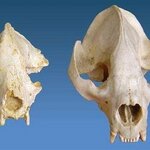Evolution

In their study,A first-principles model of early evolution: Emergence of gene families, species, and preferred protein folds, Shakhnovich et al present a new model of early biological evolution – the first that directly relates the fitness of a population of evolving model organisms to the properties of their proteins.
Key to understanding biological evolution is an important, but elusive, connection, known as the genotype-phenotype relationship, which translates the survival of entire organisms into microscopic selection for particular advantageous genes, or protein sequences. The study of…

A Cornell study of genome sequences in African-Americans, European-Americans and Chinese suggests that natural selection has caused as much as 10 percent of the human genome to change in some populations in the last 15,000 to 100,000 years, when people began migrating from Africa.
The study looked for areas where most members of a population showed the same genetic changes. For example, the researchers found evidence of recent selection on skin pigmentation genes, providing the genetic data to support theories proposed by anthropologists for decades that as anatomically modern humans migrated…

Researchers from the European Molecular Biology Laboratory now reveal that the hypothalamus and its hormones are not purely vertebrate inventions, but have their evolutionary roots in marine, worm-like ancestors.
Hormones control growth, metabolism, reproduction and many other important biological processes. In humans, and all other vertebrates, the chemical signals are produced by specialized brain centers such as the hypothalamus and secreted into the blood stream that distributes them around the body.
Hormone-secreting brain centers are much older than expected and likely evolved from…

A team of American and Irish researchers has concluded that the mysterious appearance in 2001 of an infant female bonnethead shark at Omaha's Henry Doorly Zoo in a tank that held only two adult female sharks was the result of parthenogenesis (Gr. virgin birth.) Parthenogenic reproduction takes place without fertilization by a male through the process of cell division, when the mother's egg fuses with a degenerative cell called a polar body, producing a new individual.
What does this mean for the evolution of the species?
"Parthenogenesis appears to be a rare phenomenon in sharks, and it is…

Although it may sound like an oxymoron, a University of Iowa anthropologist and his colleagues report the first discovery of a skull from a "pygmy-sized" giant panda -- the earliest-known ancestor of the giant panda -- that lived in south China some two million years ago.
The ancestor of today's giant panda really was a pygmy giant panda, says Russell Ciochon, UI professor of anthropology. Previous discoveries of teeth and other remains made between 1985 and 2002 had failed to establish the animal's size.
Ciochon says that the ancient panda (formally known as Ailuropoda microta, or "pygmy…

I took a long weekend so I guess this story is a few days old but I had to relay it because it is so funny! Thanks to Hank Campbell who organizes Scientific Blogging for sending it along.
The Creation Museum of Petersburg, Kansas has been wrought with criticism since before it even opened, but most recently, they have been embroiled in a ‘moral scandal’ by an employee hired to tell the story of the fall of man.
A variety of actors were hired to play out scenes from the bible and the man chosen to play God’s golden boy, Adam, has now been revealed to have a ‘sordid’ history. Eric Linden, owns…

This week's issue of Science has a book review (subscription required unfortunately) of Michael's Behe's latest effort to defend Intelligent Design Creationism. Michael Behe's latest book, The Edge of Evolution, contains Behe's latest incarnation of his idea of irreducible complexity. A few years ago he put forward this latest argument in a paper in Protein Science (a journal which one of my mentors dismissed, maybe a little unfairly, as a "junk journal"), and he elaborates on this argument more extensively in his new book. (See a response to Behe's Protein Science paper here.)
The argument…

It's long been thought that humans hunted woolly mammoths to extinction. Anthropogenic global hunting, as it were. Or that a cataclysmic event did the trick.
It may be neither of those and just simple genetics.
DNA lifted from the bones, teeth, and tusks of the extinct mammoths revealed a “genetic signature” of a range expansion after the last interglacial period. After the mammoths’ migration, the population apparently leveled off, and one of two lineages died out.
They don't think these guys did it any more
“In combination with the results on other species, a picture is emerging of…
Scientists at the University of California, Santa Barbara have discovered significant clues to the evolutionary origins of the nervous system by studying the genome of a sea sponge, a member of a group considered to be among the most ancient of all animals. The findings are published in the June 6 issue of the online, open-access journal PLoS ONE.
“It turns out that sponges, which lack nervous systems, have most of the genetic components of synapses,” said Todd Oakley, co-author and assistant professor in the Department of Ecology, Evolution and Marine Biology at UC Santa Barbara.…

Scientists at the University of Liverpool have found that humans’ ability to walk upright developed from ancestors foraging for food in forest tree tops and not from walking on all fours on open land.
It was traditionally thought that humans became upright walkers in a slow process which had its origins in ‘knuckle-walking’ – movement on all fours – just as chimpanzees and gorillas walk today. It was believed that this developed once human ancestors moved out of the forests into the savannahs of East Africa.
Study at the University of Liverpool, in collaboration with the University of…